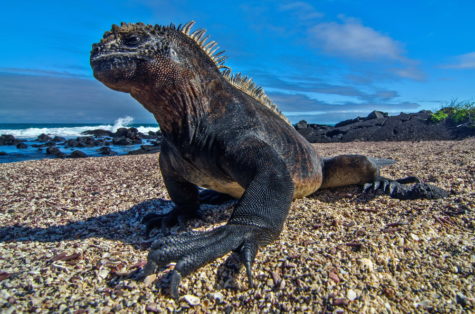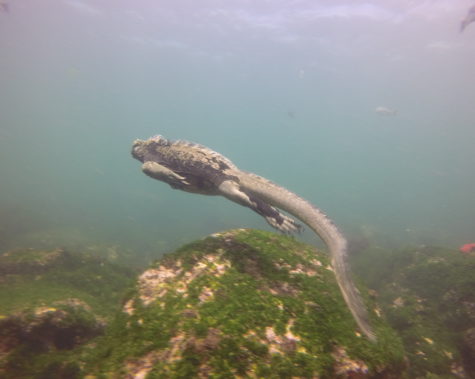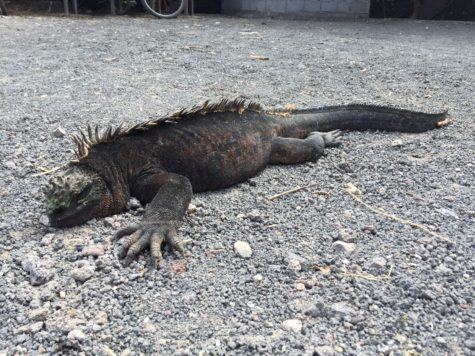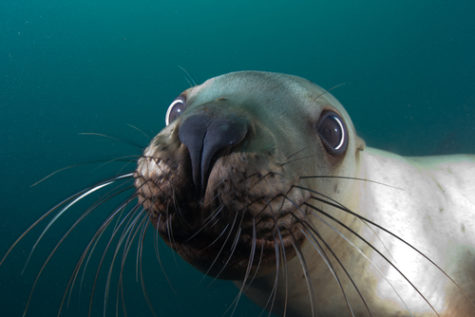 So, summer is coming to an end again (damn you, ephemeral summer!) and I’ve been thinking about past summers’ best adventures. For me, a best adventure is always going to include wild animals. In this case, it was the funny-faced marine iguanas I met in the Galapagos. They didn’t give a shit about me, but I fell hard for them. My one-sided love story, from last August, is reprinted below.
So, summer is coming to an end again (damn you, ephemeral summer!) and I’ve been thinking about past summers’ best adventures. For me, a best adventure is always going to include wild animals. In this case, it was the funny-faced marine iguanas I met in the Galapagos. They didn’t give a shit about me, but I fell hard for them. My one-sided love story, from last August, is reprinted below.
I was in the Galapagos Islands in July, which felt a bit like traveling to another planet. At least, that’s what I’d imagine an interplanetary hop to be like. The land features are familiar and yet not quite—lava fields still sharp and freshly black or dotted with hopeful plant life, colossal rocks turned to sculpture by water and wind, animals that are recognizable except acting strangely (birds that swim instead of fly, seals that bask under cacti, giant lizards that glom onto coral and munch algae—under water).
It’s that last one, the marine iguana—endemic to the Galapagos, as many animals there are—that I’ll focus on here. I fell in love with these weird little dudes, warts and all. Visitors encounter plenty of the reptiles on land—where they’re just a bit speedier than tortoises, when moving at all. Mostly, they just lie still, spread out and basking. Where old lava meets the sea they’re all over the place, sometimes packed together for warmth (especially the young ones). There are brown ones, but most are ashy gray or black, some with white markings, even wholly white tails, that help turn them invisible on the bird-poop-streaked rocks. (I don’t know if bird poop actually drove this patchy coloration, but it hides them well.) Apparently, during mating time, their skin may turn rosy, as if blushing. I guess when lizard love is in the air, never mind camouflage.
With their blunt, sedated-old-man faces, Ginsu claws, and back mohawks (my term for the “dorsal crest,” the line of bendy spikes jutting out from the back of the neck to the base of the tail), the animals might make terrific reptilian bad-guy action figures. (The Mona Lisa smile is a ruse.) In the water—we dove with them at Cabo Douglas off the north-west side of Fernandina Island—they press their arms tightly against their bodies, legs together, and essss along with surprising grace, propelled by swishes of their flattened tails (one of their special adaptations for this life). You’ll have to work hard to keep up…until they make a stop, which they do often. Then you can hang out with them, nice and close, if the rolling tide doesn’t wash you away.
 These are rough waters, but scaled, thick forearms and toes like witch fingers with talon-like tips let them hold tight to algae-coated rocks as waves attempt to topple them. On those rocks they gobble up seaweed with horrendous manners, faces in their plates.
These are rough waters, but scaled, thick forearms and toes like witch fingers with talon-like tips let them hold tight to algae-coated rocks as waves attempt to topple them. On those rocks they gobble up seaweed with horrendous manners, faces in their plates.
I loved watching them eat. They were mad-hungry little ogres down there, ripping and tearing algae with their teeth, nom nom nom, letting go to ride the current to another rock, grabbing on again, pausing for a moment looking for a thick crop, tilting their heads to the side, then going in for another round of chomping. Nom nom nom. I swear I could hear them making that sound—in what could only be deep, gravely voices—before they tucked in their arms and took off like superheroes in pursuit. Give an iguana a cape; who knows what superpowers may emerge.
The environment has turned them sea-ready, but marine iguanas still rely on air to breathe. (Numerous online sources report they can hold their breath for 30 minutes or longer.) Many, especially the females—which are smaller and lose heat faster—simply keep their heads above water, feeding on drenched rocks at low tide. But those who dive in—the biggest males, who can handle the very cold water—must come up to inhale. Squinting across the surface I’d spot a dozen little black heads popping up Jack-in-the-Box style, here, then there, then over there. Very quickly each would disappear. The pop-up heads brought to mind Whack-A-Mole, a totally inappropriate thought in a national park full of unique, protected species. (It’s not a very nice game.)

The sardine schools in the shallows were massive and tight, with thousands of silvery slivers flashing in the sun as they moved in perfect synch. What a thrill to swim through one of these ‘bait balls,’ the fish parting like theater curtains, and have a marine iguana greet you on the other side. It would be startling if you hadn’t met one before, this so-ugly-it’s-cute iguana flying at you through the sea.
Would a nod of greeting or some eye contact with us have killed them? No. But it was refreshing to be ignored rather than feared: The iguanas acted as if we weren’t there pointing and laughing at them. (It was gentle pointing and loving laughter, for the record.) A lot of animals in truly protected areas seem more relaxed around people because they haven’t experienced harassment or harm at human hands. If only it were that way everywhere. Still, now and then an iguana would smack a diver with its tail as it swam by, probably unintended, or maybe payback for all the stalking (and pointing and laughing).
Though hyper focused on feeding their faces, having no interest in frolicking with silly humans, the marine iguanas won my heart—in part because nom nom nom–despite offering nothing emotional in return. Thank goodness for the playful sea lions, zipping within reach and meeting our gazes with those sweet, mammalian eyes, for keeping our egos intact.

Photo credits:
Top, Iguana: Shutterstock (their pics are better than mine)
Middle, Swimming Iguana: Walter Torres (guide); Basking Iguana by the author
Bottom, Sea Lion: OMG So Cute! Shutterstock